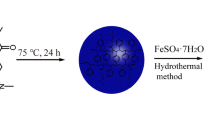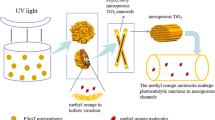Abstract—
We have studied photoelectrochemical and photocatalytic properties of porous materials based on hollow α-Fe2O3 microspheres, characterized by the presence of dangling magnetic Fe–O–Fe bonds due to an increased oxygen vacancy concentration on the wall/closed pore interface. Using such powder and firing slips at an isothermal holding temperature of 400°C, we obtained two series of thin-film samples on glass with a conductive layer from suspensions of two compositions: aqueous Fe(NO3)3 solution + hollow α-Fe2O3 microspheres (series 1) and aqueous Fe(NO3)3 solution + polyethylene glycol + hollow α-Fe2O3 microspheres (series 2). The films of series 2 were shown to have a structure with spatially separated particles differing in size: α-Fe2O3 nanoparticles and hollow α-Fe2O3 microspheres. The films of series 1 consisted predominantly of hollow microspheres connected by “necks” formed during heat treatment. The thickness of the films of series 2 was of order 2 μm and that of the films of series 1 was of order 4 μm. The structural distinctions between the films of the two series had a significant effect on the optical properties of the material. In the wavelength range 350–1500 nm, the absorption coefficient of the films of series 2 (3.50 × 105 m–1) was about twice that of the films of series 1 (1.75 × 105 m–1). Photoelectrochemical characterization in an aqueous 0.1 M KOH solution showed that the onset potential for the anodic reaction was 0.87 V vs. Ag/AgCl in the case of the films of series 2 and 0.97 V vs. Ag/AgCl in the case of series 1. The films of both series showed an unusual increase in current density during prolonged illumination at a potential of 1 V vs. Ag/AgCl, due to Fe(IV) formation on the photoanode surface. Photocatalytic properties of the materials were assessed from the rate of methylene blue degradation. The reaction rate constant (k) was determined to be 0.015 and 0.018 min–1 for the films of series 1 and 2, respectively, whereas the k of the photocatalyst-free reaction was 2.8 × 10–4 min–1.

















Similar content being viewed by others
REFERENCES
Wang, Y., Torres, J.A., Shviro, M., Carmo, M., He, T., and Ribeiro, C., Photocatalytic materials applications for sustainable agriculture, Prog. Mater. Sci., 2022, vol. 130, p. 100965. https://doi.org/10.1016/j.pmatsci.2022.100965
Kiselev, V.M., Evstrop’ev, S.K., and Starodubtsev, A.M., Photocatalytic degradation and sorption of methylene blue on the surface of metal oxides in aqueous solutions of the dye, Opt. Spectrosc., 2017, vol. 123, no. 5, pp. 909–815. https://doi.org/10.1134/S0030400X17090168
Mikhailov, D.A., Lelet, M.I., Fukina, D.G., and Lelet, Yu.N., Photocatalytic properties of the MgHPO4· 3H2O and MgKPO4·6H2O phosphates, Inorg. Mater., 2022, vol. 58, no. 6, pp. 620–629. https://doi.org/10.1134/S0020168522060061
Cheng, X.-M., Zhao, J., and Sun, W.-Y., Facet-engineering of materials for photocatalytic application: status and future prospects, EnergyChem, 2022, vol. 4, no. 5, p. 100084. https://doi.org/10.1016/j.enchem.2022.100084
Belikov, M.L. and Safaryan, S.A., Adsorptive and photocatalytic properties of molybdenum-modified titanium dioxide, Inorg. Mater., 2022, vol. 58, no. 7, pp. 715–722. https://doi.org/10.1134/S0020168522070032
Bie, Ch., Wang, L., and Yu, J., Challenges for photocatalytic overall water splitting, Chem, 2022, vol. 8, no. 6, pp. 1567–1574. https://doi.org/10.1016/j.chempr.2022.04.013
Wang, Q., Tian, S., and Ning, P., Degradation mechanism of methylene blue in a heterogeneous Fenton-like reaction catalyzed by ferrocene, Ind. Eng. Chem. Res., 2014, vol. 53, no. 2, pp. 643–649. https://doi.org/10.1021/ie403402q
Ameta, S.C. and Ameta, R., Advanced Oxidation Processes for Waste Water Treatment, London: Academic, 2018.
Gopinath, M. and Marimuthu, R., A review on solar energy-based indirect water-splitting methods for hydrogen generation, Int. J. Hydrogen Energy, 2022, vol. 47, no. 89, pp. 37742–37759. https://doi.org/10.1016/j.ijhydene.2022.08.297
Coronado, J.M., Fresno, F., Hernández-Alonso, M.D., and Portela, R., Design of Advanced Photocatalytic Materials for Energy and Environmental Applications, London: Springer, 2013. https://doi.org/10.1007/978-1-4471-5061-9
Pleskov Yu.V. Fotoelektrokhimicheskoe preobrazovanie solnechnoi energii (Photoelectrochemical Conversion of Solar Energy), Moscow: Khimiya, 1990.
Moridon, S.N.F., Yunus, K.A.R.M., Minggu, L.J., and Kassim, M.B., Photocatalytic water splitting performance of TiO2 sensitized by metal chalcogenides: a review, Ceram. Int., 2022, vol. 48, no. 5, pp. 5892–5907. https://doi.org/10.1016/j.ceramint.2021.11.199
Costa, M.B., Araújo, M.A., Lima Tinoco, M.V., Brito, J.F., and Mascaro, L.H., Current trending and beyond for solar-driven water splitting reaction on WO3 photoanodes, J. Energy Chem., 2022, vol. 73, pp. 88–113. https://doi.org/10.1016/j.jechem.2022.06.003
Piccinin, S., The band structure and optical absorption of hematite (α-Fe2O3): a first-principles GW-BSE study, Phys. Chem. Chem. Phys., 2019, vol. 21, no. 6, pp. 2957–2967. https://doi.org/10.1039/C8CP07132B
Tamirat, A.G., Rick, J., Dubale, A.A., Su, W.-N., and Hwang, B.-J., Using hematite for photoelectrochemical water splitting: a review of current progress and challenges, Nanoscale Horiz., 2016, vol. 1, no. 4, pp. 243–267. https://doi.org/10.1039/C5NH00098J
Malviya, K.D., Klotz, D., Dotan, H., Shlenkevich, D., Tsyganok, A., Mor, H., and Rothschild, A., Influence of Ti doping levels on the photoelectrochemical properties of thin-film hematite (α-Fe2O3) photoanodes, J. Phys. Chem. C, 2017, vol. 121, no. 8, pp. 4206–4213. https://doi.org/10.1021/acs.jpcc.7b00442
Fernández-Climent, R., Giménez, S., and García-Tecedor, M., The role of oxygen vacancies in water splitting photoanodes, Sustain. Energy Fuels, 2020, vol. 4, no. 12, pp. 5916–5926. https://doi.org/10.1039/D0SE01305F
Wang, Y., Zhang, J., Balogun, M.-S., Tong, Y., and Huang, Y., Oxygen vacancy-based metal oxides photoanodes in photoelectrochemical water splitting, Mater. Today Sustain., 2022, vol. 18, p. 100118. https://doi.org/10.1016/j.mtsust.2022.100118
Yang, Q., Du, J., Li, J., Wu, Y., Zhou, Y., Yang, Y., Yang, D., and He, H., Thermodynamic and kinetic influence of oxygen vacancies on the solar water oxidation reaction of α-Fe2O3 photoanodes, ACS Appl. Mater. Interfaces, 2020, vol. 12, no. 12, pp. 11625–11634. https://doi.org/10.1021/acsami.9b21622
Hu, J., Zhao, X., Chen, W., and Chen, Z., Enhanced charge transport and increased active sites on α-Fe2O3 (110) nanorod surface containing oxygen vacancies for improved solar water oxidation performance, ACS Omega, 2018, vol. 3, no. 11, pp. 14973–14980. https://doi.org/10.1021/acsomega.8b01195
Zhang, Z., Karimata, I., Nagashima, H., Muto, S., Ohara, K., Sugimoto, K., and Tachikawa, T., Interfacial oxygen vacancies yielding long-lived holes in hematite mesocrystal-based photoanodes, Nat. Commun., 2019, vol. 10, no. 1, p. 4832. https://doi.org/10.1038/s41467-019-12581-z
More, P.D., Jadhav, P.R., Ghanwat, A.A., Dhole, I.A., Navale, Y.H., and Patil, V.B., Spray synthesized hydrophobic α-Fe2O3 thin film electrodes for supercapacitor application, J. Mater. Sci.: Mater. Electron., 2017, vol. 28, no. 23, pp. 17839–17848. https://doi.org/10.1007/s10854-017-7725-5
Liang, T., Guo, X., Yuan, B., Kong, S., Huang, H., Fu, D., Zhang, F., Xu, J., and Li, X., Design of functionalized α-Fe2O3 (III) films with long-term anti-wetting properties, Ceram. Int., 2020, vol. 45, no. 5, pp. 6129–6135. https://doi.org/10.1016/j.ceramint.2019.11.077
Zhang, Y., Su, Y., Wang, Y., He, J., McPherson, G.L., and John, V.T., Rapid fabrication of hollow and yolk-shell α-Fe2O3 particles with applications to enhanced photo-Fenton reactions, RSC Adv., 2017, vol. 7, no. 62, pp. 39049–39056. https://doi.org/10.1039/C7RA06621J
Bokstein, B.S., Esin, V.A., Rodin, A.O., and Svetlov, I.L., Models for the porosity growth and dissolution in single-crystal nickel-base superalloys, Defect Diffus. Forum, 2010, vols. 297–301, pp. 187–192. https://doi.org/10.4028/www.scientific.net/DDF.297-301.187
Lian, J., Duan, X., Ma, J., Peng, P., Kim, T., and Zheng, W., Hematite (α-Fe2O3) with various morphologies: ionic liquid-assisted synthesis, formation mechanism, and properties, ACS Nano, 2009, vol. 3, no. 11, pp. 3749–3761. https://doi.org/10.1021/nn900941e
Van der Wood, F., Mossbauer effect in α-Fe2O3, Phys. Status Solidi, 1966, vol. 17, no. 1, pp. 417–432. https://doi.org/10.1002/pssb.19660170147
Knyazev, Yu.V., Chumakov, A.I., Dubrovskiy, A.A., Semenov, S.V., Yakushkin, S.S., Kirillov, V.L., Martyanov, O.N., and Balaev, D.A., Mössbauer study of the magnetic transition in ϵ-Fe2O3 nanoparticles using synchrotron and radionuclide sources, JETP Lett., 2019, vol. 110, no. 9, p. 613–617. https://doi.org/10.1134/S0021364019210082
Kopkova, E.K., Maiorov, D.V., and Kondratenko, T.V., Production and investigation of the structural, surface, and sorption properties of layered double hydroxides of magnesium and aluminium modified with polyethylene glycol, Sorbts. Khromatogr. Protsessy, 2022, vol. 21, no. 6, pp. 894–904. https://doi.org/10.17308/sorpchrom.2021.21/3836
Mitra, S., Das, S., Mandal, K., and Chaudhuri, S., Synthesis of a α-Fe2O3 nanocrystal in its different morphological attributes: growth mechanism, optical and magnetic properties, Nanotechnology, 2007, vol. 18, no. 27, p. 275608. https://doi.org/10.1088/0957-4484/18/27/275608
Freitas, A.L.M., Muche, D.N.F., Leite, E.R., and Souza, F.L., Interface engineering of nanoceramic hematite photoelectrode for solar energy conversion, J. Am. Ceram. Soc., 2020, vol. 103, pp. 6833–6846. https://doi.org/10.1111/jace.17390
Zhong, D.K. and Gamelin, D.R., Photoelectrochemical water oxidation by cobalt catalyst (“Co–Pi”)/α-Fe2O3 composite photoanodes: oxygen evolution and resolution of a kinetic bottleneck, J. Am. Chem. Soc., 2010, vol. 132, no. 12, pp. 4202–4207. https://doi.org/10.1021/ja908730h
Walter, M.G., Warren, E.L., McKone, J.R., Boettcher, S.W., Mi, Q., Santori, E.A., and Lewis, N.S., Solar water splitting cells, Chem. Rev., 2010, vol. 110, no. 11, pp. 6446–6473. https://doi.org/10.1021/cr1002326
Krysa, J., Zlamal, M., Kment, S., Brunclikova, M., and Hubicka, Z., TiO2 and Fe2O3 films for photoelectrochemical water splitting, Molecules, 2015, vol. 20, pp. 1046–1058. https://doi.org/10.3390/molecules20011046
Xiao, C., Zhou, Z., Li, L., Wu, S., and Li, X., Tin oxygen-vacancy co-doping into hematite photoanode for improved photoelectrochemical performances, Nanoscale Res. Lett., 2020, vol. 15, no. 1, p. 54. https://doi.org/10.1186/s11671-020-3287-1
Kennedy, J.H. and Frese, K.W., Photooxidation of water at α-Fe2O3 electrodes, J. Electrochem. Soc., 1978, vol. 125, no. 5, p. 709. https://doi.org/10.1149/1.2131532
Upul Wijayantha, K.G., Saremi-Yarahmadi, S., and Peter, L.M., Kinetics of oxygen evolution at α-Fe2O3 photoanodes: a study by photoelectrochemical impedance spectroscopy, Phys. Chem. Chem. Phys., 2011, vol. 13, no. 12, pp. 5264–5270. https://doi.org/10.1039/C0CP02408B
Peter, L.M., Upul Wijayantha, K.G., and Tahir, A.A., Kinetics of light-driven oxygen evolution at α-Fe2O3 electrodes, Faraday Discuss., 2012, vol. 155, pp. 309–322. https://doi.org/10.1039/C1FD00079A
Braun, A., Sivula, K., Bora, D.K., Zhu, J., Zhang, L., Grätzel, M., Guo, J., and Constable, E.C., Direct observation of two electron holes in a hematite photoanode during photoelectrochemical water splitting, J. Phys. Chem. C, 2012, vol. 116, no. 32, pp. 16870–16875. https://doi.org/10.1021/jp304254k
Deng, J., Lv, X., and Zhong, J., Photocharged Fe2TiO5/Fe2O3 photoanode for enhanced photoelectrochemical water oxidation, J. Phys. Chem. C, 2018, vol. 122, no. 51, pp. 29268–29273. https://doi.org/10.1021/acs.jpcc.8b08826
Vasiljevic, Z.Z., Dojcinovic, M.P., Vujancevic, J.D., Jankovic-Castvan, I., Ognjanovic, M., Tadic, N.B., Stojadinovic, S., Brankovic, G.O., and Nikolic, M.V., Photocatalytic degradation of methylene blue under natural sunlight using iron titanate nanoparticles prepared by a modified sol–gel method, R. Soc. Open Sci., 2020, vol. 7, no. 9, p. 200708. https://doi.org/10.1098/rsos.200708
Ma, M., Yang, Y., Chen, Y., Ma, Y., Lyu, P., Cui, A., Huang, W., Zhang, Z., Li, Y., and Si, F., Photocatalytic degradation of MB dye by the magnetically separable 3D flower-like Fe3O4/SiO2/MnO2/BiOBr-Bi photocatalyst, J. Alloys Compd., 2021, vol. 861, p. 158256. https://doi.org/10.1016/j.jallcom.2020.158256
Vu, X.H., Phuoc, L.H., Dien, N.D., Pham, T.T.H., and Thanh, L.D., Photocatalytic degradation of methylene blue (MB) over α-Fe2O3 nanospindles prepared by a hydrothermal route, J. Electron. Mater., 2019, vol. 48, no. 5, pp. 2978–2985. https://doi.org/10.1007/s11664-019-07056-2
Funding
This work was supported by the Russian Foundation for Basic Research, project no. 20-38-90166.
Author information
Authors and Affiliations
Corresponding author
Ethics declarations
The authors declare that they have no conflicts of interest.
Rights and permissions
About this article
Cite this article
Demirov, A.P., Blinkov, I.V., Belov, D.S. et al. Photocatalytic Properties of Porous Films Based on α-Fe2O3 Hollow Microspheres. Inorg Mater 59, 272–283 (2023). https://doi.org/10.1134/S0020168523030032
Received:
Revised:
Accepted:
Published:
Issue Date:
DOI: https://doi.org/10.1134/S0020168523030032




